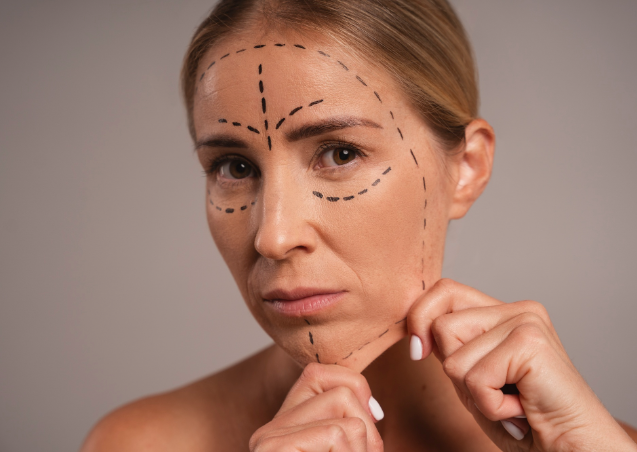
Facial fat grafting is a cosmetic procedure designed to enhance and rejuvenate facial features. This technique involves harvesting fat from one area of the body and carefully transferring it to specific areas of the face. The goal is to achieve a more balanced, youthful, and aesthetically pleasing appearance.
This procedure can address a variety of concerns, including improving the appearance of scars, filling areas with lost tissue, correcting facial asymmetry, and restoring volume that has diminished due to aging or other factors. Depending on the extent of the enhancements desired, fat grafting can be performed in a single session or across multiple sessions for more complex cases.
Facial fat grafting is usually carried out under general anesthesia, ensuring patient comfort throughout the procedure. The process involves three key stages :
The surgeon begins by extracting fat from a donor site, commonly the thighs, abdomen, or flanks. This step is performed using a specialized liposuction technique that minimizes trauma to the fat cells, ensuring their viability for transplantation.
Once collected, the fat is carefully processed to remove impurities such as blood and excess fluids. This step ensures that only the healthiest fat cells are used for grafting, increasing the likelihood of successful integration into the target area.
The surgeon then makes small, strategically placed incisions or needle punctures in the facial areas requiring enhancement. These tiny openings are designed to accommodate the placement of the fat grafts with minimal scarring. Using fine cannulas, the purified fat is meticulously injected into the target areas in layers, allowing for precise contouring and natural-looking results.
After the grafting is complete, the surgeon may close the incisions if necessary, though in many cases, needle punctures do not require suturing. The results are often visible immediately, with improvements continuing as swelling subsides and the grafts integrate into the surrounding tissues.
Facial fat grafting surgery offers a versatile solution for enhancing facial aesthetics and addressing various concerns. This procedure is designed to restore lost volume, improve symmetry, and reduce the appearance of imperfections, making it a popular choice for facial rejuvenation. Here's a closer look at the key benefits of facial fat grafting:
Facial fat grafting can significantly improve the overall appearance of facial features. It effectively:
One of the notable advantages of this procedure is its minimally invasive nature. As an outpatient surgery, most patients experience:
Facial fat grafting boasts a high success rate, delivering durable results when performed by a skilled surgeon. The transplanted fat integrates seamlessly with the existing tissue, providing a natural appearance that can last for years.
It is essential, however, to have a thorough discussion with your surgeon regarding the potential risks and benefits before undergoing the procedure. A personalized consultation ensures realistic expectations and optimal outcomes.
Facial fat grafting is relatively affordable compared to other cosmetic procedures. However, it is vital to have a detailed discussion with your surgeon about the costs involved. This ensures clarity and helps prevent any potential misunderstandings regarding pricing or additional expenses.
One of the standout benefits of fat grafting is its ability to deliver natural-looking results. Since the procedure uses the patient's own fat tissue harvested from another part of the body, the outcome appears organic and harmonious with existing facial features.
Facial fat grafting surgery is a popular cosmetic procedure designed to enhance facial features by transferring fat from one part of the body to specific areas of the face. Proper preparation is crucial to ensure a smooth procedure and optimal results. Here are some essential steps to get ready for your surgery:
The first and most important step is selecting a qualified and experienced surgeon. Look for a board-certified plastic surgeon with a proven track record in facial fat grafting. Conduct thorough research, read reviews, and schedule a consultation to discuss your goals, ask questions, and address any concerns. A reputable surgeon will guide you through the process and set realistic expectations.
Your surgeon will perform a comprehensive pre-operative evaluation to assess your overall health and suitability for the procedure. This may include:
These evaluations ensure the procedure is safe for you and helps the surgeon tailor the approach to your needs.
If you smoke, it's essential to stop at least two weeks before the surgery, as smoking can impede healing and affect results. Additionally, inform your surgeon about any medications, supplements, or herbal remedies you are taking. Some drugs, such as blood thinners, may need to be paused to minimize the risk of complications during and after surgery.
Your surgeon will provide detailed pre-operative guidelines to prepare your body for the procedure. These may include:
Your surgeon will provide a set of pre-operative instructions designed to prepare you for the procedure and optimize your results. These may include:
Following these guidelines diligently is crucial to ensuring a smooth procedure and the best possible outcome.
Facial fat grafting is an outpatient procedure, so you'll need to plan for assistance after your surgery. Consider the following:
Proper post-operative planning ensures your comfort and safety, helping you focus on healing.